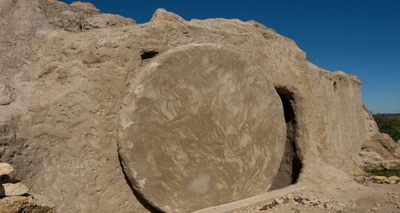Thoughts for the Day
Saturday, 30th March 2024: Resting in the tomb
Matthew 27 Joseph of Arimathea Tomb Gnosticism Pilate John 19 Jesus
Reading : Verses from Matthew, Chapter 27

When it was evening, there came a rich man from Arimathea, named Joseph, who was also a disciple of Jesus. He went to Pilate and asked for the body of Jesus; then Pilate ordered it to be given to him. So Joseph took the body and wrapped it in a clean linen cloth and laid it in his own new tomb, which he had hewn in the rock. He then rolled a great stone to the door of the tomb and went away. Mary Magdalene and the other Mary were there, sitting opposite the tomb.
The Guard at the Tomb
The next day, that is, after the day of Preparation, the chief priests and the Pharisees gathered before Pilate and said, ‘Sir, we remember what that impostor said while he was still alive, “After three days I will rise again.” Therefore command that the tomb be made secure until the third day; otherwise his disciples may go and steal him away, and tell the people, “He has been raised from the dead”, and the last deception would be worse than the first.’ Pilate said to them, ‘You have a guard of soldiers; go, make it as secure as you can.’ So they went with the guard and made the tomb secure by sealing the stone.
(Lectionary, New Revised Standard Version)
Thoughts
We are used to the idea of conspiracy theories - that men haven't gone to the moon comes to mind, but there are also many others. Social media ratchets up the ideas about many things, until no-one knows what is real and what is fake. But the question of whether Jesus died isn't new. For nearly 2,000 years there have been many conspiracy theories.
In our reading from Matthew's Gospel we see his account of the burial of Jesus. It's slightly different to the one we saw yesterday in John's Gospel (19.38-42). We don't get the secret disciple who creeps around at night, we get a confident Jewish leader, Joseph of Arimathea who goes to demand the body of Jesus. In John's account there is no mention that he 'rolled a great stone to the door of the tomb' in front of witnesses. Neither do we get the soldiers guarding the tomb. Matthew's account is considered to be much earlier than John's and he is concerned that we should know that Jesus really died, and was buried, and did rise again. This is no illusion, as many of the gnostics (see Further Thoughts below) were to later claim.
Ultimately this is a matter of faith, that Jesus was in his grave and descended to Sheol, the place of the dead, where he rested on the Saturday. Because our Lord experienced this agonising death and was sealed in a tomb, we should be comforted that there is no place where God is not with us! He is with us at our birth, during our life, and at our death. As Psalm 139 verse 8, says: 'If I ascend to heaven, you are there; if I make my bed in Sheol, you are there.' We, and our Saviour, must wait patiently for the miracle of the Resurrection on Easter morning.
Prayer
Heavenly Father,
as the women and the soldiers guard the tomb
where Your Son lies dead,
may we too wait patiently this day,
secure in the promise that He made,
that He would rise on the third day.
Calm our minds and hearts
to know that the final acts of His love
must still be played out at the Resurrection,
at His Ascension,
and at the coming of the Holy Spirit at Pentecost.
Amen.
If you want to know more about Gnosticism, look at this article, especially the 2nd and 4th paragraphs:
You might like to play this old hymn late at night or early Easter morning - it touches on Holy Saturday and Easter morning: